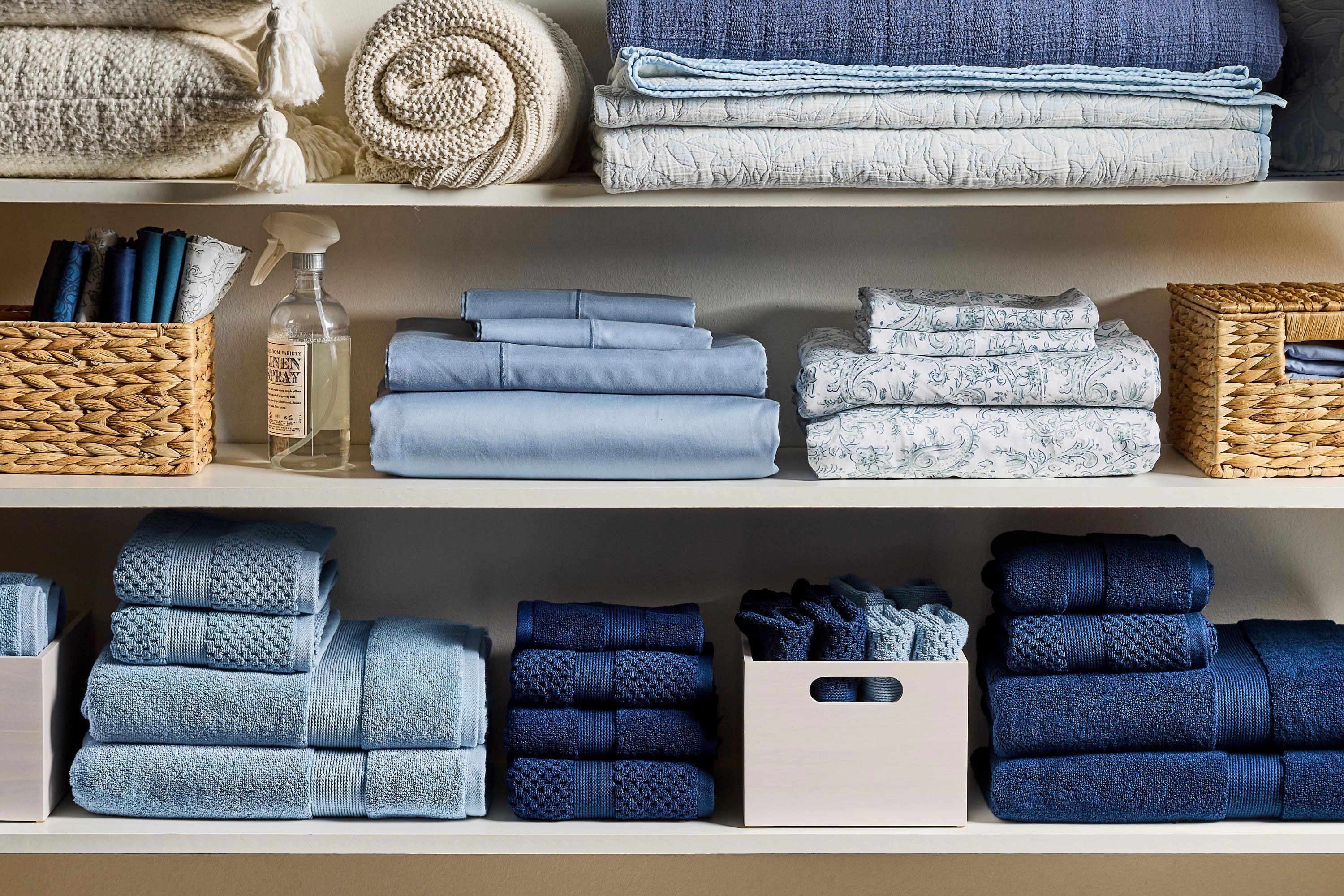Perhaps you have a large household, frequent visitors, or need to declutter your closet. Or maybe you only have a handful of extra blankets, sheets, and pillows floating around. Either way, bedding needs a proper place to be stored when not in use.
A standard solution is to stuff sheets and blankets into the linen closet. But that approach isn’t always the best solution. And some households lack a linen closet entirely. Depending on the amount of stuff you own and the size of the space you’re in, one (or more) of the following bedding storage ideas is bound to help you get better organized. So, the next time your in-laws pop in for a surprise stay, you can make up the guest bed faster than you can pour a glass of your favorite wine.
Kelsey Hansen / Sheets: Better Homes & Gardens Collection at Walmart
1. Employ the Bed-in-a-Bag Method
To keep matching sheet sets, including fitted sheets, flat sheets, and pillowcases, together, try this bedding storage solution. First, find all of the pieces, then master the art of folding each one into a rectangle, leaving one pillowcase off to the side. Put the sheets and pillowcases into a pile and slide everything into the remaining pillowcase. This not only keeps the set together but also keeps the bedding compact, allowing it to fit more easily into a small space. Lay the “bed in a bag” on a shelf in the linen closet, tucked into a dresser drawer, or folded into a basket alongside others (just be sure the opening faces up so nothing falls out).
2. Utilize Vacuum-Sealed Bags
Vacuum-sealed bags are a storage essential. These clear, heavy-duty bags come in a variety of sizes and are an excellent option for bulky bedding. If you’re short on storage space but need extra pillows and comforters for guests, consider storing them flat and stacking them on a high shelf. This also comes in handy if you frequently change your bedding with the seasons.
While the best vacuum-sealed storage bags do a good job of keeping out air and moisture, they’re best used only for a short period. However, employing them for seasonal or guest bedding purposes helps you rotate linens enough to prevent any potential issues. If you want to leave bedding, such as a sentimental quilt, inside a bag indefinitely, it’s essential to periodically open the bag and refold the item. Also, use a permanent marker or label to mark what’s in each bag so you know where something is at all times.
Kelsey Hansen
3. Store Bedding in a Fabric Bag
An alternative to vacuum-sealed bags, fabric or polypropylene storage bags can be used to store blankets and pillows. Many have a clear window in the front, allowing you to see what’s inside, and a handle for easy transport. While they don’t shrink down and save as much space, storage bags do keep your bedding neat and orderly. Find one that’s wide yet shallow and slide it under your bed so it stays out of the way but within reach.
Related
4. Use a Bench or Basket
For extra throw blankets and sheet sets, consider a wide-mouthed basket that complements the room’s aesthetic. Pop items into the basket whenever they’re not in use. A bench with hidden storage also works well, especially for bed pillows. Place one at the end of your bed to tuck in extra sheets and blankets instead of cluttering up a linen closet. An ottoman in the living room that lifts can also hold extra throw blankets, which can be quickly grabbed for family movie night.
5. Hang Heavy Blankets
When folded, large blankets take up precious shelf or drawer space that's better used for smaller items. Instead, locate some room in a seldom-used closet, such as in the guest bedroom, or to the back or far sides of your clothes closet to hang your blankets. Use sturdy wooden hangers or consider open-ended chrome hangers explicitly designed for blankets. This allows blankets to slide on and off the hanger effortlessly. If hanging space isn't available, consider a small standing garment rack in a storage room or a blanket ladder.
Frequently Asked Questions
-
A comforter can last from 10 to 25 years. However, down comforters tend to last longer than alternatives. You should discard your comforter when it becomes torn, stained, or no longer provides you with proper comfort and warmth.
-
You should wash your bedsheets every 1-2 weeks. Meanwhile, your comforter and pillows should be cleaned every 1-6 months, depending on whether or not they have a protective layer. If there's no protective layer, then they should be washed more frequently.
-
This is not recommended. Plastic bags and airtight containers can trap moisture, allowing mold or mildew to grow.



